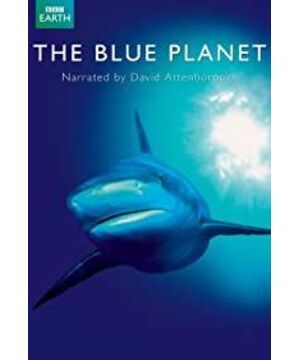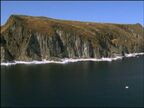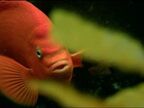01 blue planet
The blue whale is the largest animal in the ocean. Its tongue is as heavy as an elephant, and some blood vessels are wide enough to swim through it. Its tail fin is as wide as the wing of a small airplane, but it depends on it. What survives is one of the smallest creatures in the ocean-krill. A blue whale can eat tens of millions of krill in one day.
Krill will gather in the shallows and dye the sea red.
The distribution of marine life depends on the direction of ocean currents full of nutrients and the intensity of sunlight.
The smooth-eyed shark is particularly good at catching injured fish.
The sharks congregate into the largest group of sharks in the ocean. Sometimes thousands of sharks will cruise around a submarine mountain at the same time, because some creatures here can do cleaning services for them.
Sardines→gannets; sardines→white-eyed mackerels; sardines→real dolphins;
Krill → Black-browed Albatross
The Jason Minaret is a remote island located on the west side of the Falkland Islands. It has the largest albatross habitat in the world.
The daily light and heat brought by sunlight are necessary for the growth of tiny plankton, and plankton is the foundation of all marine life.
When the sun disappeared on the horizon, billions of metric tons of marine life rose from the deep ocean to a place close to the water in search of food. It was eating plankton under the cover of darkness, but it was not safe at all. Other predators in the ocean followed. At the break of dawn, the entire team returned to the safe embrace of the deep secluded sea.
The gravity of the moon causes daily tides to rise and fall. When the moon is neither a full moon nor a new moon, the tides are the weakest and the sea is relatively calm.
The annual cycle of the sun has the most comprehensive impact on everything. The relative position of the sun and the earth constantly changes throughout the year, which is also the cause of the seasons.
A female herring can lay 20,000 eggs.
The migration process of gray whales is one of the longest in marine life, with a total length of 12,000 miles back and forth. Leaded by males and infertile females. At the end of the line is the female who has just given birth. The strongest young whales can only swim a few nautical miles a day (strength swim only about 3 hours).
The killers follow the gray whales to migrate every year. The killers are usually super naughty, calling friends and shouting non-stop, but once they find the trail of the prey, they are as quiet as a group turning the switch. The prey of killer whales is juvenile whales.
The body of the killer whale is only half the size of the female gray whale, and the tail fin of the female gray whale can cause great damage.
After 6 hours of hunting, the killer whale got the trophy of the baby whale, but only ate the jaw and tongue of the baby whale.
On the dark bottom of the sea, a hagfish can eat rotten flesh several times its body weight within a few hours.
02 deep sea
More than 60% of our planet is covered by more than a mile of ocean.
The deep sea bottom is an unprecedented strange world, and new species will be discovered almost every time you dive.
There are more people who have been to space than those who have been to the deep sea.
A sperm whale floats up and takes a breath, and it can stay underwater for an hour.
The survival of the twilight zone depends on seeing and not being seen.
After sinking to a depth of one thousand meters, we entered the dark zone. No sunlight could penetrate here. The temperature of the sea dropped below four degrees Celsius, and the pressure was 100 times that on land.
Sunlight only has a direct effect on the sea above 100 meters, photosynthesis can only be carried out here, and coral reefs can only be formed here.
Crossing the edge of the coral reef, you immediately enter another hard-to-live world, with only animals but no plants.
At present, only 5 submarines in the world can dive into the ocean basin, and they have explored only 1% of the basin.
In the very center of the Ocean Basin, there is the largest geographic structure on the planet-the Mid-Ocean Ridge-and it is also the largest mountain range on the planet, stretching for more than 80,000 miles.
On the sea surface, water turns into water vapor at 100 degrees. But on the ocean floor, under tremendous pressure, the water remains in a liquid state even at a high temperature of 400 degrees.
Pompeii can tolerate high temperatures above 80 degrees and is currently the most heat-resistant animal known.
03 vast ocean
The ocean thousands of miles away from the land is the most lifeless place on the earth, like an ocean desert. But here also live some of the most agile and ferocious sea hunters.
The red swordfish is a fierce carnivorous animal. Hunt and eat sardines during the day.
The survival rate of juvenile yellowfin tuna may be only one in a million.
Fork-tailed petrel is dancing on the sea. This is not a pleasant waltz, but is actually hunting for food. When they ridicule and soar, they will pick up scraps such as fish eggs from near the surface of the water.
Mackerel, the only way to resist predators is to gather into a pellet. Any fish that missed the line will be eaten immediately. In the cluster of pellets, there are still some chances of survival.
Sailfish is one of the fastest fish in the ocean. Sailfish rely on eyesight so they usually act during the day. When the sailfish is excited, the body will change color and appear blue stripes.
Flying fish is listed on the menu of all large carnivores, so they spend their entire lives in the sea escaping.
Any floating object on the sea is a shelter for small fish.
The sunfish is the ultimate bony fish in the sea. Most sunfish live in the deep sea and feed on jellyfish. Occasionally go to a place near the water to warm up.
The flying dolphins will spin out of the water, which is obviously just a social performance. Because the prey is plentiful, hundreds of them gather here to show off their skills.
04
96
View more about The Blue Planet reviews









